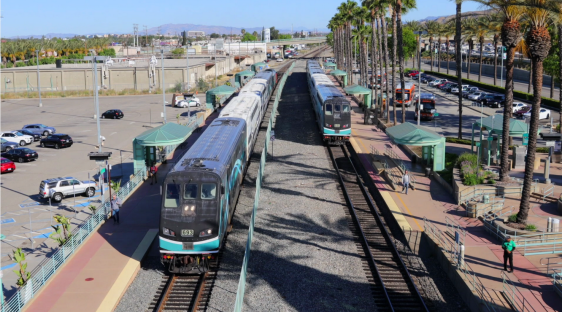 SFMTA Executive Director Nat Ford talks service hours in his office yesterday. Photos: Bryan Goebel
SFMTA Executive Director Nat Ford talks service hours in his office yesterday. Photos: Bryan GoebelIn just over a week, Muni will cut bus frequencies across the system by perhaps the greatest amount in its history. Roughly 313,000 service hours will be cut out of the schedule [PDF], leaving riders to wait an average of 10 percent longer for buses and trains. Depending on the line and the time of day, riders could see increased waits of one to ten minutes for each bus, with fifteen extra minutes between some overnight bus lines.
Still, Muni says the cuts, which its board approved to cover budget deficits this year and in the next two, are not random or across the board. In an interview with Streetsblog, San Francisco Municipal Transportation Agency (SFMTA) Executive Director Nat Ford, who oversees Muni, stressed that the cuts would be focused on the least-crowded lines and times of day, while many of the most-used lines would be spared at peak hours.
"It is less frequent service that's out there," Ford acknowledged, but, he said, "We didn't just take a hatchet to the system and lop 10 percent off of every route. We used the [Transit Effectiveness Project] information … to make informed decisions. We were able to look at the system surgically."
Muni's most popular lines are generally spared from huge frequency
changes, in part because even minor changes will undoubtedly add to
crowding on lines that are already packed. For instance, the Stockton
corridor, one of Muni's most heavily traveled, won't see any headway
changes.
Another example Ford highlighted is the 1-California, one of the heaviest-used lines and one that won't see a radical slashing of service hours. Morning peak service is unchanged, midday service is a minute less frequent east of Presidio Avenue and unchanged west of it, evening peak service is a minute less frequent and late evening service is unchanged.
Yet, no matter how surgical SFMTA schedule planners are, there's
no way to cut 10 percent of Muni's service hours without cutting a lot
of meat. Lines like the 22-Fillmore will see changes that riders could find very difficult to stomach. On May 8, the 22 -- already known for overcrowding -- will run every 20 minutes instead of every 15 minutes in the early evening, and every half hour instead of every 20 minutes by 11 p.m.
 Ford discusses service changes with Streetsblog reporters Matthew Roth and Michael Rhodes (right).
Ford discusses service changes with Streetsblog reporters Matthew Roth and Michael Rhodes (right). That's going to put a lot of pressure on Muni to avoid bunching of buses and missed runs, but Ford maintains that the new schedule will be more realistic given Muni's maintenance and staffing challenges.
"What we've done right now is we essentially have a service cut out there, but it's an ad-hoc, impromptu service cut," said Ford. "You walk out there, you don't know if the trip that you're expecting is going to show up or not, and you don't know if it's because of a vehicle reliability issue or an operator availability issue."
After May 8, said Ford -- and riders will certainly hold him to this -- the system should be smaller, but more reliable.
"What we're proposing is, by shrinking the system slightly, 10 percent here in terms of service hours, and being very strategic in terms of where we're doing it, we'll have an adequate amount of parts and equipment, maintenance personnel to maintain it, [and an] adequate number of operators to fill the work."
Rail Rehab Projects Will Spare Operators from Cuts
One quirk of the timing of the cuts is that the SFMTA may not actually need to lay off many operators, even though it had originally planned to cut 170 positions. That's because the agency has a number of capital improvement projects on its rail system in the coming months that will require replacing rail service with bus service and that bus service will be paid for with capital dollars, not operating funds.
For the first project, the St. Francis Circle rail replacement, which also starts on May 8, Muni will need to replace each rail trip with four to five buses and thus each rail operator with four to five bus operators. That will take about 140 operators total, meaning 140 of the operators cut from regular service will be moved over to operating the bus shuttles. Then, on September 1, the SFMTA will begin the Church and Duboce rail rehab project, again providing jobs for operators cut from regular service.
"Frankly," said Ford, "without this service modification, we would have a difficult time. We would be paying overtime to run the bus substitution for St. Francis Circle."
With less service in its schedule, Muni expects to have extra buses available, which will also go toward the rail rehab projects. As for the remaining 30 or so operators of the 170, Ford expects many of those positions will be lost anyway to attrition, termination, retirement, and promotion.
Ideally, said Ford, most of the operators working replacement service would still be around when Muni expects to have enough money to restore the cut service hours, so it won't have to hire and train new drivers. (Of course, there's hearty debate already about Muni's ability to minimize the service cuts immediately.)
The SFMTA also points out that the service changes on December 5th actually resulted in a modest increase in the total number of service hours it delivers, even as it saved money on scheduling efficiencies. But this time around, the cuts will be to the bone, and Muni riders will be waiting longer no matter how well the system is managed.
Looking to May 8, Ford said, "I've got a smaller system here, so I've got to make sure every run is making it out there every day."
How will your Muni lines be affected on May 8? Are you getting hit hard by headway increases or spared the worst of it? Check out Muni's comparison chart [PDF] and let us know in the comments section below.





